Work associated with the formation of dust, the release of poisonous gases, vapors, require the arrangement of the workplace and premises with an exhaust system. In most cases, DIY ventilation in a workshop is the most affordable way to solve the problem.
There are various options for building air exchange systems. We will help you navigate in their variety, consider the features of building ventilation for each type of workshop. Let's analyze the most effective and affordable options for self-installation.
The content of the article:
- Types of ventilation systems in the workshop
-
Features of the arrangement of ventilation in the workshop
- #1. Dust extraction in a carpentry workshop
- #2. Air purification in car service
- #3. Repair and blacksmith workshop ventilation
-
Options for building ventilation in the workshop
- Option # 1 - exhaust ventilation from plastic pipes
- Option # 2 - dust collector from KAMAZ filter
- Option # 3 - aspiration system in the carpentry shop
- Conclusions and useful video on the topic
Types of ventilation systems in the workshop
According to the method of air circulation in the room, there are two main types of ventilation:
- natural;
- forced.
In the first case, the movement of air occurs due to the temperature difference inside the room and outside.
And in the second, the circulation is provided by fans that create excess pressure or vacuum in the workshop. This ventilation is also called mechanical ventilation.
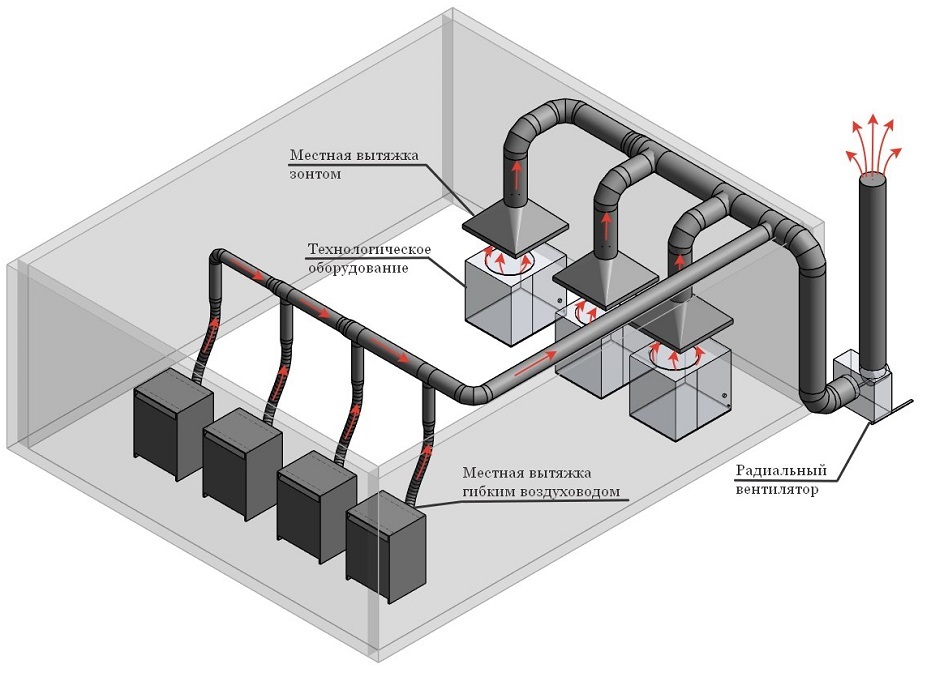
The rapid removal of contaminated air from the workshop is impossible without mechanical ventilation. But this does not mean that natural extraction is not used in such rooms, they often complement each other.
In turn, forced is of the following types:
- exhaust;
- supply;
- combined.
Exhaust ventilation ensures the removal of harmful gases, vapors, while clean air enters the workshop in a natural way. Supplyon the contrary, it creates excessive pressure inside the room due to the intake of street air, and the spent air is squeezed out of the workshop through natural openings and cracks. If necessary, the inlet stream can be heated, cleaned, or humidified.
Combined the ventilation system of the workshop is called supply and exhaust. Depending on the relative position of the air supply and exhaust channels, circulation can take place by displacement or stirring.
If the supply fans are at the bottom, then the cold air rises displaces the warmer air. With the upper location of the inlet channel, the cold flow is distributed throughout the room, going down, it mixes with the warmer one. The exhaust air is then removed by an exhaust duct.
Depending on the method of organization, ventilation in the workshop is divided into two types:
- local;
- centralized.
The first is used to remove harmful substances directly from the workplace. It is advantageous to use it to localize pollution when pieces of equipment are removed from each other over the entire area of the room.
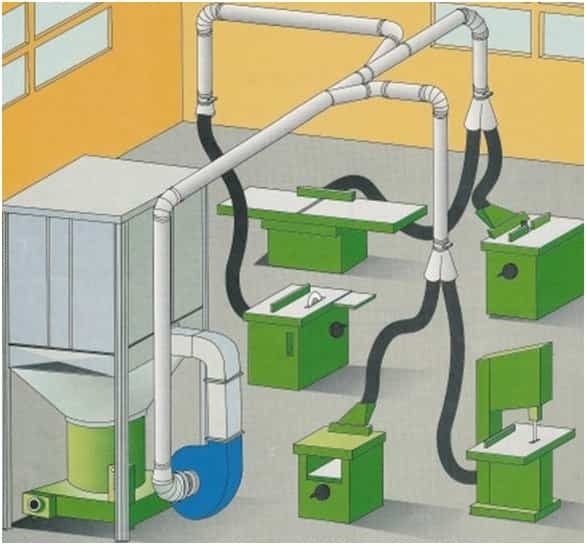
Correct organization of the aspiration system eliminates explosive wood dust, preserves the health of workers. The centralized system is used for high intensity and continuity of work in the workshop
For small workshops with a more compact arrangement of machines, it is advisable to install a centralized hood.
Also apply hybrid ventilation optionswhen some of the machines are connected to a common system, and some have local filtration. In some cases, in principle, only local systems are preferred to prevent the spread of fine dust and other toxic substances throughout the workshop.
Features of the arrangement of ventilation in the workshop
Work in the workshop is associated with the presence of poisonous and harmful substances in the air. The design and construction of ventilation in such rooms depends on the type of work and the nature of the harmful factors.
Let's consider the main features that affect the configuration and parameters of ventilation systems for different types of workshops.
#1. Dust extraction in a carpentry workshop
Fine dust is a major problem in woodworking workshops. Such a suspension of particles can remain in the air for 24 hours, although it is not noticeable to the eyes, but is inhaled by the lungs. In addition, it is deposited on all surfaces. With any draft or starting the engines of machines, tools, it again appears in the air.
Organization of dust removal system (aspiration) is complicated by the presence of a large number of dust sources and different fractions of shavings. For this reason, it is necessary to supply suction arms with individual filtration to each machine.
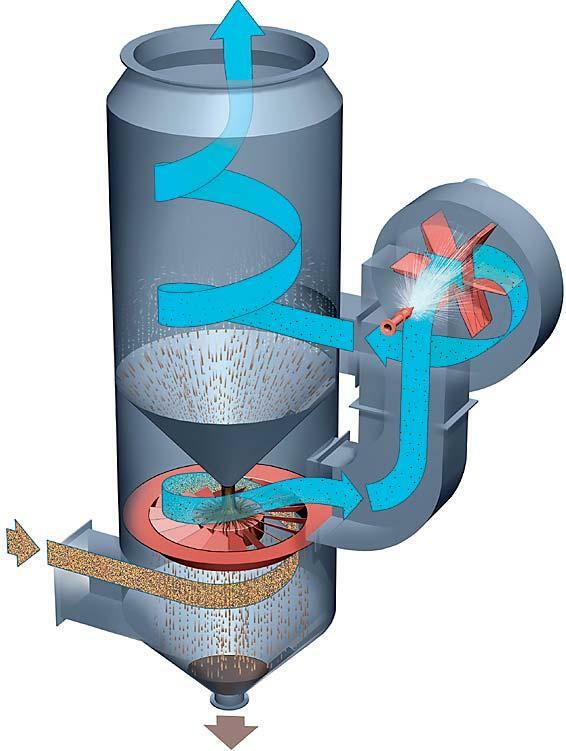
Dust extraction systems operate on the cyclone principle. The contaminated air is sucked in by the rotating movement of the fan and, under the action of centrifugal force, the heavier dust particles sink to the bottom of the container. The purified air rises upward. Additionally, the stream can be moistened for better cleaning.
But, in addition to the harmful effect on breathing, wood dust also has fire and explosive properties. That makes increased demands on ventilation systems in terms of excluding electrostatics and earthing of structures.
#2. Air purification in car service
Car service workshop refers to premises with high air pollution. The constant presence of exhaust gases, carbon monoxide and nitrogen, aerosols, gasoline vapors, paint and other technical fluids makes special demands on the performance of the ventilation system. The power of the supply and exhaust unit is selected with a margin to ensure the pumping of the entire volume of the room with the recommended multiplicity of 20 - 30.
In addition, the polluted air must be filtered and removed by a separate pipe from the general ventilation.
#3. Repair and blacksmith workshop ventilation
The products of combustion of electrodes, smoke, fumes and dust released during welding and metalworking work during cutting and metal processing require removal by means of local hoods. What is regulated GOST 12.3.003, SP 49.13330, POT R M 020-2001 [22], STO 221 NOSTROY 2.10.64-2013and safety rules in the production of construction and installation, gas welding and electric welding works.
For manual electric welding, their approximate performance is selected based on the provision of air exchange from 1500 to 4500 thousand. m3* h / kg divided by the weight of the electrodes burned in 1 hour.
With semi-automatic welding, the volume is increased to 1700 - 2000 thousand. m3* h / kg.

Ventilation of the welder's workplace is of paramount importance. Vapors of metals and slag contain harmful oxides of manganese, compounds of silicon, titanium and others chemical elements that lead to diseases of the nervous system, lungs, are able to accumulate in organism
The total air circulation is distributed in the ratio of supply to exhaust 1: 3 for the upper tier, and 2: 3 for the lower one.
The peculiarity of the ventilation of the blacksmith's workshop is the need to remove excess heat and poisonous gases. For this, local suction over the furnaces and natural ventilation are used.
When calculating the performance of ventilation systems for all types of workshops according to the recommended frequency, it is necessary to take into account the heat loss in the cold season. The choice of the maximum parameters will guarantee the quick removal of harmful substances, but at the same time, will require the cost of heating the supply air. If heat recovery is not provided, it is better to opt for the lower permissible multiplicity limits.
Options for building ventilation in the workshop
In search of the best ways to build ventilation for your own workshop, you have to revise many possible options before finding the most suitable one.
To facilitate this search, consider, as an example, the most successful, in our opinion, solutions for the independent arrangement of ventilation in the workshop.
Option # 1 - exhaust ventilation from plastic pipes
For the implementation of this project were used: a used centrifugal fan "snail" with an electric motor 2, 2 kW, barrel for 40 - 50 liters with a neck corresponding to the inlet of the "snail", plastic sewer pipes 110 mm.

A centrifugal fan, as opposed to an axial fan, creates more pressure. This makes it possible to build on its basis more extended and branched ventilation systems in the workshop.
A few words about the material of the air ducts. The use of plastic sewer pipes for ventilation is a fairly popular option, primarily due to the price. They are several times cheaper than plastic and steel ventilation ducts.
But sewer pipes also have their drawbacks:
- they cannot be used in places where the temperature can exceed +60 degrees;
- they do not have an antistatic coating, so it is not advisable to use them for chip and dust removal systems;
- their diameters do not meet the standards of ventilation systems, which makes it difficult to interface with other equipment.
Despite these disadvantages, in most cases, sewer pipes are successfully used as air ducts. The considered variant of the ventilation system device made of scrap materials was no exception.
In this project, all the main hood units for the locksmith shop were made by hand. Let's briefly describe the stages of the work done.
So, at first, a major overhaul and revision of the centrifugal fan was made. The revision concerned the inlet pipe. More precisely, due to its absence, it was necessary to make a new one from a small sealed barrel, the volume of which would allow the fan to gain the required vortex flow speed.
A side hole was made in the barrel and a piece of plastic pipe was glued in, taking into account aerodynamics, so that the inlet flow would go along the inner circumference of the barrel. Then a duct made of plastic pipes was installed under the ceiling in the center along the entire workshop.
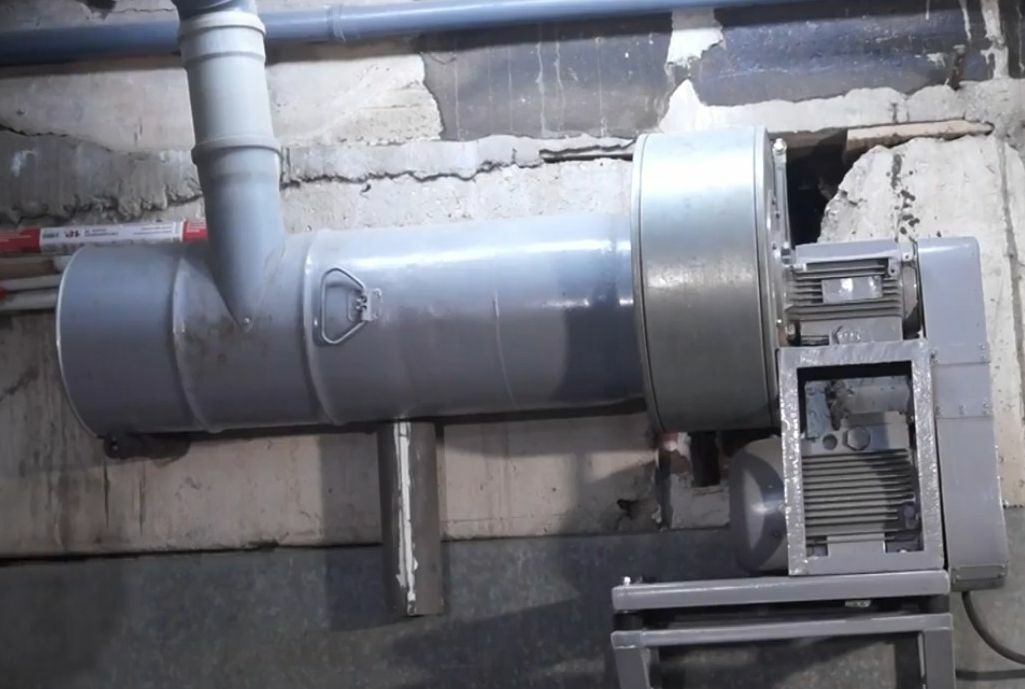
The barrel in this project plays the role of a receiver, which is created with the prospect of expanding the ventilation system by embedding several inlet pipes
The centrifugal fan creates a powerful vortex flow in the barrel, which ensures rapid air circulation throughout the system. Its strength is so great that it keeps the grinder's saw blade at the farthest inlet.
The parameters of the exhaust system are as follows:
- engine power 2, 2 kW;
- fan speed 2800 rpm;
- capacity 1000 m3/ h - 1500 m3/ч;
- the time for drawing the entire volume of air out of the workshop is 5 - 10 minutes.
The whole system has 6 air inlets closed with self-made adjustable plugs. They are made of standard plastic ones with cut-out slots in the lid, and the same slots in a movable metal plate, fixed on one axis. With their mutual rotation, the air flow is regulated.
Option # 2 - dust collector from KAMAZ filter
Since factory dust extraction systems are quite expensive, homemade dust collectors based on air filters from large trucks such as KamAZ, tractors or harvesters.
By complementing such a filter with a fan, you get a good air purifier that takes up a minimum of space and can be easily carried to any part of the workshop.
The performance of such a system is regulated by the selection of the fan power. Such filters are capable of purifying air volumes from 500 to 1000 m3 per hour, depending on the type. They can be connected to fans with a capacity of up to 300 - 400 m3/ч.
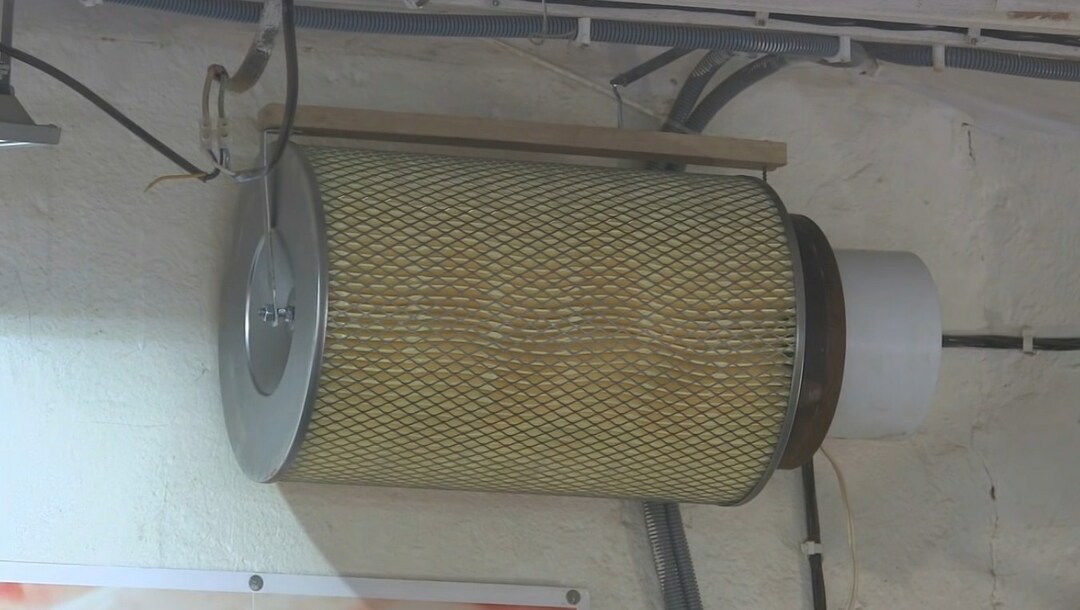
The dust extractor can be hung from the ceiling. The mount should allow the equipment to be removed and cleaned periodically. This is best done with compressed air outdoors.
Assembling an air purifier is quite simple. To do this, you need to cut out the flange, fix the hairpin on the axis to the length of the filter. Next, glue the fan to the flange and screw the entire structure to the filter.
Due to their ease of manufacture and low cost, several such filters can be made and significantly improve the air in the entire workshop.
Option # 3 - aspiration system in the carpentry shop
The main role in the proposed dust extraction system is played by the JET factory chip extractor. The cost of such equipment, depending on the parameters, is 15-40 thousand. rub. Most models have a cloth dust collector and a chip bag.
For this option, the best model JET DC-1200CK with a paper filter element in the form of a removable drum was chosen. It is equipped with a manual internal cleaner that removes the main dust without removing the filter.
The ventilation pipes were selected for maximum ESD protection and least resistance to air flow. Coiled galvanized steel pipes meet these requirements in the best way.
When they were installed, a multimeter was used to check the reliability of the electrical contact in the connection nodes. If necessary, the contact was reinforced with two self-tapping screws from opposite sides. The entire pipeline was grounded. In addition, the joints were wrapped with aluminum tape for tightness.
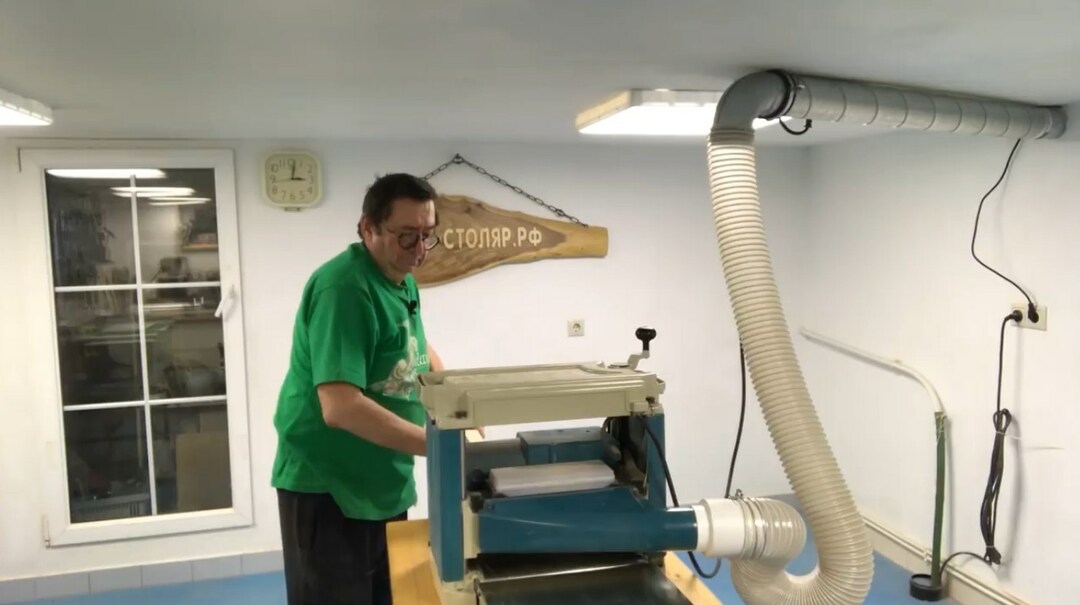
The work in the workshop is organized in such a way that all workbenches and machines can be moved on wheels to the center of the room and connected to the exhaust corrugation as they are used. This ensures that the workshop is almost perfectly clean and dust-free.
To reduce noise and dust, the exhaust unit was moved outside the workshop to the adjacent boiler room. The supply line is routed through an opening in the wall under the ceiling. The inlet is fixed to the ceiling in the middle of the workshop. He is wearing a corrugated two-meter pipe made of transparent plastic.
In addition to aspiration, air exchange in the carpentry workshop is provided by supply and exhaust ventilation.
Conclusions and useful video on the topic
One of the options for the hood in the workshop:
Where is the best place for the chip suction? More on this in the following video:
Option for arranging a mobile hood for a workshop:
The options discussed above do not cover all the many ways to independently build ventilation in a workshop. But, at a minimum, they will help you choose the right direction for implementing your own project and avoid a long journey of trial and error. Practice shows that a ventilation system of sufficient performance for a workshop can be designed and installed with your own hands.
Do you have any questions about the ventilation arrangement in the workshop? Or do you want to tell other users how you organized an effective air exchange and dust removal system on your own using materials at hand? Share your experience, ask questions to our experts - the comment block is located below this publication.


